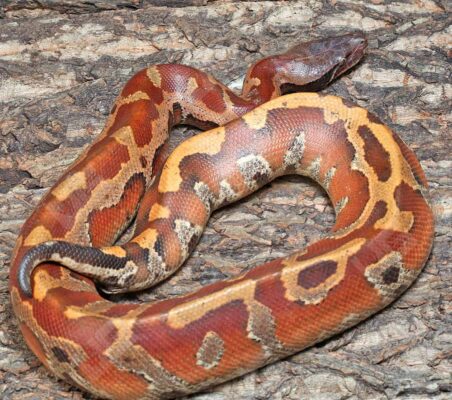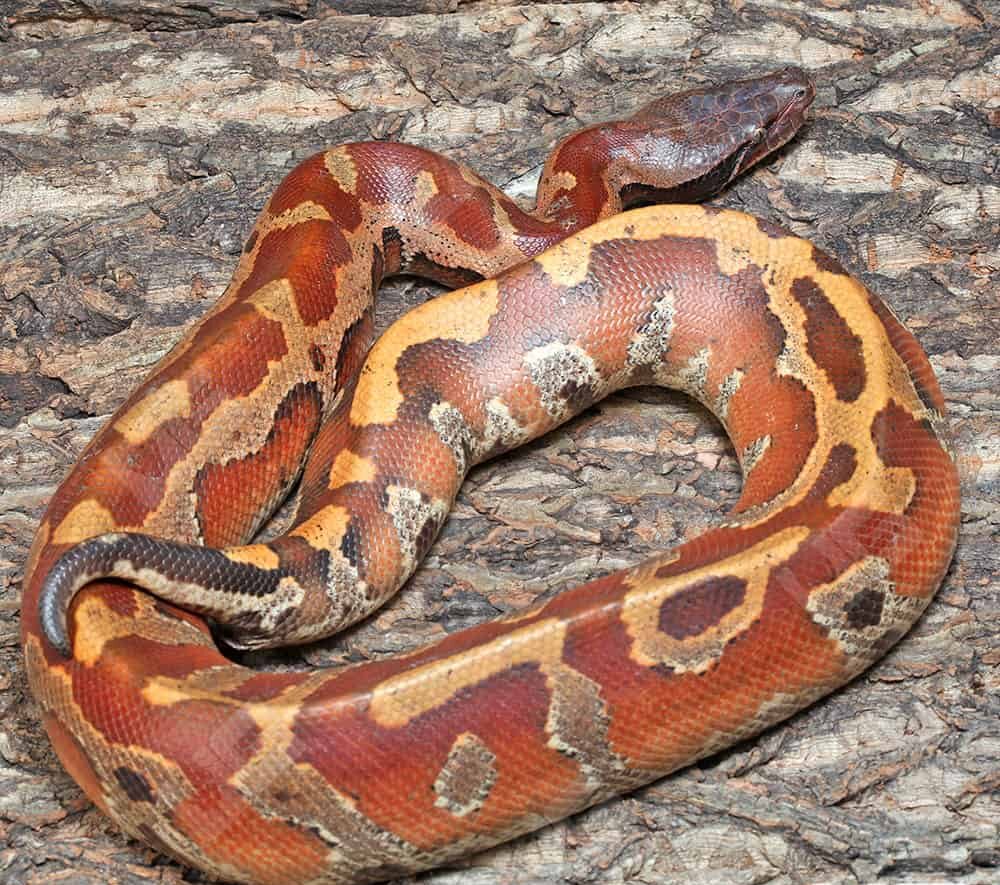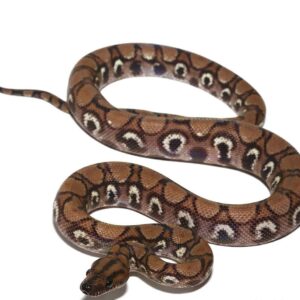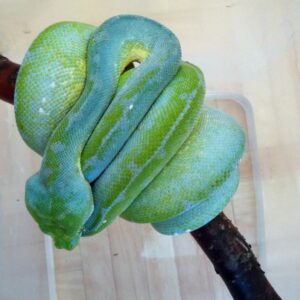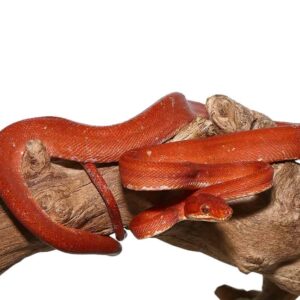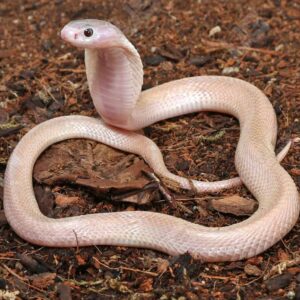Bangka Blood Python For Sale
$349.99
WE HAVE BABY BANGKA BLOOD PYTHONS FOR SALE. HERE ARE SOME HIGHLIGHTS:
- Python curtus
- Captive Bred
- Approximately 4 Feet In Length
- Adults Can Grow Up To 4 – 5 Feet In Length
- This Species Can Be Feisty But With Regular Handling Tames Down Well
- Feeding On Live And Frozen/Thawed Rat Pups
FUN FACTS!
- These Originate From The Island Of Borneo In Indonesia
- Blood Pythons Are Terrestrial Snakes Living Their Lives On The Forest Floor Blending In With The Leaf Litter And Attacking Prey By Surprise
- This Species Can Be Feisty But With Regular Handling Tames Down Well
- With Proper Care These Snakes Can Live Up To 20 – 25 Years At A Time
Description
The Bangka Blood Python, scientifically known as Python brongersmai, is a captivating species within the python family. Renowned for its vibrant coloration and robust physique, this python is native to the Bangka Island in Indonesia, as well as parts of Malaysia and Thailand. Its striking appearance and unique characteristics make it a subject of great interest among herpetologists and reptile enthusiasts alike.
Characterized by its stout body and relatively short length compared to other pythons, the Bangka Blood Python typically measures between three to six feet in length. Its coloration ranges from deep reds and oranges to yellows and browns, often with intricate patterns that enhance its visual appeal. The species is sexually dimorphic, with females generally being larger and more robust than males. This dimorphism is particularly evident during breeding seasons, where the females’ size provides a distinct advantage in nurturing offspring.
One of the most notable features of the Bangka Blood Python is its adaptability to various habitats. While it predominantly resides in swamps, marshes, and tropical forests, it can also thrive in more arid environments. This adaptability underscores the species’ resilience and evolutionary success within its native range.
In the broader context of the python family, the Bangka Blood Python holds a unique position. It belongs to the subfamily Pythoninae, which includes other well-known species such as the Burmese Python and the Ball Python. However, the Bangka Blood Python’s distinctive coloration and body structure set it apart, making it a fascinating subject for scientific study and captive breeding programs.
Understanding the basic characteristics and unique features of the Bangka Blood Python provides a foundation for appreciating its ecological significance and the role it plays in its natural habitat. As we delve deeper into the specifics of this remarkable species, its intriguing aspects will become even more apparent.
Habitat and Distribution
The Bangka Blood Python, a remarkable species, primarily inhabits the island of Bangka in Indonesia. This region’s unique ecosystem provides an ideal environment for these pythons, contributing significantly to their prevalence and survival. The lush rainforests of Bangka offer dense foliage and ample humidity, which are essential for the Bangka Blood Python’s well-being. Rainforests provide a rich tapestry of undergrowth and canopy cover, creating perfect conditions for these pythons to thrive.
In addition to rainforests, the Bangka Blood Python is also found in swampy areas. Swamps, with their murky waters and abundant vegetation, offer an excellent breeding ground and hunting territory. The high humidity and consistent availability of water in swamps are crucial for the python’s skin health and hydration. These environments also support a diverse array of prey, ensuring a steady food supply.
Agricultural areas on Bangka Island also serve as habitats for these pythons. The transformation of forests into farmlands has inadvertently provided new niches for the Bangka Blood Python. These agricultural zones often border natural forests and swamps, allowing the pythons to traverse between different habitats. Farm animals and smaller wildlife in these areas become part of the python’s diet, showcasing their adaptability to varied environments.
Environmental factors play a pivotal role in the survival of the Bangka Blood Python. Humidity levels, temperature, and vegetation density are critical. These pythons thrive in regions where the temperature remains consistently warm, with high humidity levels ensuring their skin stays hydrated and healthy. Dense vegetation not only provides cover from predators but also helps maintain the microclimate necessary for their survival.
Thus, the Bangka Blood Python’s distribution is largely dictated by the availability of suitable habitats that meet their ecological needs. Their presence in rainforests, swamps, and agricultural areas on Bangka Island underscores the importance of these environments in supporting their population.
Physical Characteristics
The Bangka Blood Python, scientifically known as Python brongersmai, is a remarkable species, particularly noted for its robust physique and striking coloration. Typically, an adult Bangka Blood Python measures between 4 to 6 feet in length, although some individuals may grow larger under optimal conditions. Despite its relatively modest length compared to other python species, the Bangka Blood Python is distinguished by its notably thick and muscular body, which can weigh anywhere from 10 to 25 pounds. This hefty build serves as an adaptive trait, enabling the snake to constrict its prey effectively.
One of the most captivating features of the Bangka Blood Python is its vivid and diverse coloration. The species exhibits a palette ranging from deep reds and oranges to rich yellows, often interspersed with irregular patterns of dark brown or black. This unique coloration not only serves as a visual hallmark but also provides the snake with excellent camouflage within its natural habitat. The striking hues of the Bangka Blood Python make it a popular choice among reptile enthusiasts and collectors.
Sexual dimorphism is another notable aspect of the Bangka Blood Python. Females tend to be larger and more robust than males, a common trait among many python species. This size difference is particularly evident during the breeding season when females require additional energy reserves for egg production. Males, on the other hand, are generally more slender and agile, traits that aid in their search for mates.
In addition to its thick body, the Bangka Blood Python possesses a relatively short tail, a feature that further distinguishes it from other python species. The tail’s length is typically less than one-sixth of the snake’s total body length, contributing to its overall stocky appearance. This anatomical characteristic enhances the python’s ability to anchor itself while constricting prey, making it a highly efficient predator within its ecosystem.
Behavior and Temperament
The Bangka Blood Python, known for its vibrant coloration and robust build, exhibits fascinating behavioral patterns both in the wild and captivity. In their natural habitat, these pythons are primarily nocturnal, preferring to hunt under the cover of darkness. Their diet mainly consists of small mammals and birds, which they capture using their remarkable constricting abilities. These snakes are ambush predators, relying on their excellent camouflage to remain undetected until their prey is within striking distance.
In terms of activity levels, the Bangka Blood Python tends to be relatively sedentary. They spend a significant amount of time in a state of stillness, conserving energy for hunting and digestion. This low activity level is typical of many constrictor species, which have adapted to a lifestyle that balances energy expenditure with the needs of their metabolism.
When it comes to temperament, the Bangka Blood Python can exhibit a range of behaviors depending on its environment and handling. In the wild, these pythons can be defensive if threatened, and they may hiss or strike if they feel cornered. However, with proper care and regular, gentle handling, captive individuals can become accustomed to human interaction. It is important to approach these snakes with respect and patience, as sudden movements or rough handling can lead to stress or defensive behavior.
Special considerations are crucial when keeping a Bangka Blood Python in captivity. Providing an appropriate enclosure that mimics their natural environment, including adequate hiding spots and temperature gradients, is essential for their well-being. Regular monitoring of their health and behavior can help in identifying any signs of stress or illness early on. Additionally, understanding their feeding habits and ensuring a suitable diet will contribute to their overall health and longevity.
In summary, the Bangka Blood Python’s behavior and temperament are shaped by their natural instincts and environmental conditions. While they can be demanding in terms of care, they offer a unique and rewarding experience for those willing to invest the time and effort into understanding these remarkable reptiles.
Diet and Feeding
The Bangka Blood Python, known for its striking appearance, exhibits fascinating dietary preferences that vary significantly between wild and captive environments. In the wild, these pythons primarily prey on small to medium-sized mammals, such as rodents and birds. They are ambush predators, relying on their camouflage and patience to capture unsuspecting prey. Their feeding frequency in the wild is infrequent, often constrained by the availability of prey and the python’s slow metabolism. Typically, an adult Bangka Blood Python may consume a substantial meal every few weeks, sustaining itself on the nutrients derived from these infrequent but sizeable meals.
In captivity, the dietary regimen for the Bangka Blood Python should closely mimic its natural feeding habits to ensure optimal health and well-being. Primary prey items for captive pythons include rats and mice, which should be appropriately sized to match the girth of the python. Feeding frequency in captivity can range from every 10 to 14 days for adults, while juveniles may require more frequent meals, approximately every 5 to 7 days, to support their rapid growth and development.
Unique feeding behaviors of the Bangka Blood Python include their tendency to constrict their prey with remarkable strength before ingestion. This natural behavior should be accommodated in captivity by offering pre-killed or frozen-thawed prey to reduce the risk of injury to the python. Additionally, it is advisable to feed the python in a separate enclosure to prevent any association of the primary habitat with feeding, which can help reduce stress and potential feeding-related aggression.
To ensure the Bangka Blood Python’s health in captivity, it is crucial to provide a balanced diet, regular feeding schedule, and appropriate prey size. Monitoring the python’s weight and overall condition is essential to adjust feeding practices as needed. By closely mirroring the natural dietary patterns and addressing specific nutritional requirements, owners can promote the well-being and longevity of their Bangka Blood Python.
Reproduction and Lifespan
The reproductive cycle of the Bangka Blood Python is a captivating aspect of its biology. Mating typically occurs during the cooler months, often triggered by a decrease in temperature and changes in photoperiod. The mating behavior is characterized by a courtship process where the male exhibits tactile stimulation by rubbing and nudging the female. This ritual can last for several hours to a few days until successful copulation is achieved.
Post-mating, the female enters a gestation period lasting approximately 90 days. During this time, she exhibits increased lethargy and utilizes her thermoregulatory abilities to maintain optimal incubation temperatures within her body. The clutch size of the Bangka Blood Python can vary significantly, generally ranging from 10 to 30 eggs. After laying, the female often exhibits maternal behavior by coiling around the eggs to provide warmth and protection until they hatch, which occurs after an additional 60 to 70 days.
The lifespan of the Bangka Blood Python varies notably between wild and captive environments. In the wild, these pythons face numerous challenges, including predation, habitat loss, and disease, which can limit their lifespan to around 12 to 15 years. In contrast, with optimal care, individuals in captivity can live significantly longer, often reaching 20 to 25 years. Factors influencing longevity include diet, healthcare, habitat conditions, and genetic predispositions.
Overall, the reproductive strategies and lifespan of the Bangka Blood Python underscore its adaptability and resilience. Understanding these aspects not only enriches our knowledge of this fascinating species but also aids in the development of effective conservation and captive breeding programs, ensuring their continued survival and well-being.
Conservation Status and Threats
The Bangka Blood Python (Python brongersmai) faces a myriad of challenges that threaten its survival in the wild. Currently, the species is listed as “Near Threatened” on the International Union for Conservation of Nature (IUCN) Red List. This classification underscores the precarious position of the Bangka Blood Python, which is primarily attributed to various anthropogenic factors.
Habitat destruction is one of the foremost threats to the Bangka Blood Python. The rapid deforestation and land conversion for agricultural purposes, particularly for palm oil plantations, have resulted in significant habitat loss. This encroachment not only reduces the available natural habitat for the species but also fragments their living spaces, making it difficult for them to find food and mates.
Another major threat is poaching. The Bangka Blood Python is often captured and killed for its skin, which is highly valued in the fashion industry. The demand for exotic leather goods has led to overexploitation, significantly impacting the population numbers of this species in the wild. Additionally, the pet trade poses a substantial threat, as these pythons are sought after for their striking appearance. Unsustainable collection from their natural habitat for sale in the pet market further exacerbates their declining numbers.
In response to these threats, various conservation efforts have been initiated to safeguard the Bangka Blood Python. Legal protections have been established in some regions, regulating the trade and export of this species. Conservation organizations are also working towards habitat preservation and restoration projects, aiming to mitigate the adverse effects of deforestation. Public awareness campaigns are essential in educating local communities and the global audience about the importance of preserving this unique species.
While these efforts are commendable, continuous and collaborative measures are crucial to ensure the long-term survival of the Bangka Blood Python. Strengthening legal frameworks, enhancing habitat conservation, and promoting sustainable practices are vital steps in addressing the threats faced by this remarkable species.
Keeping Bangka Blood Pythons as Pets
Owning a Bangka Blood Python can be a rewarding experience, provided that potential pet owners are well-informed about their care requirements. Housing is the first critical aspect to consider. These pythons require a spacious enclosure to accommodate their size, which can reach up to six feet in length. A terrarium measuring at least 4 feet by 2 feet by 2 feet is recommended. The enclosure should be secure and escape-proof, equipped with a sturdy lid.
Temperature regulation is crucial for the health of Bangka Blood Pythons. These reptiles thrive in a temperature gradient of 82-88 degrees Fahrenheit during the day, with a slight drop to 75-80 degrees Fahrenheit at night. Utilizing a combination of heat lamps and under-tank heaters can effectively maintain these conditions. A reliable thermometer is essential to monitor the temperature accurately.
Humidity levels are equally important, as Bangka Blood Pythons originate from tropical environments. The enclosure should maintain a humidity level between 60-70%. This can be achieved by misting the habitat regularly and incorporating a large water bowl where the python can soak. Monitoring devices such as hygrometers can help ensure that humidity levels remain consistent.
Health care is another critical component. Regular check-ups with a reptile veterinarian are advisable to monitor for common health issues such as respiratory infections and skin conditions. It is essential to provide a varied diet primarily consisting of appropriately-sized rodents to ensure balanced nutrition.
Choosing a healthy specimen is vital. Look for signs such as bright, clear eyes, a clean vent, and smooth, unblemished skin. It is also important to ethically source your python. Reputable breeders and rescue organizations are preferred over wild-caught specimens, which can carry diseases and contribute to the decline of wild populations.
Owning a Bangka Blood Python comes with significant responsibilities. Potential owners should be prepared for the long-term commitment, as these pythons can live up to 20 years. Consistent, thorough care and a commitment to ethical practices are essential for the well-being of these fascinating reptiles.
